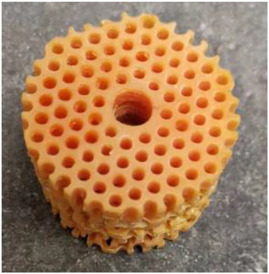Researchers from the Xi’an Modern Chemistry Research Institute in China have 3D printed a functional gun propellant using SLA technology. The gunpowder-esque substance is a carefully constructed blend of photopolymer resin, RDX (a high explosive), and other reactive additives. Initial gun testing of the 3D printed propellant has garnered some promising results, as the scientists managed to achieve a more-than-lethal muzzle velocity of 420m/s. This, of course, depends on your definition of ‘promising’.

High-velocity projectiles
Gun propellants are the chief energy source in barrel weapons, and are the driving force behind the high-velocity projectiles commonly known as bullets. In the black powder muskets of old, bullets typically exited the barrel with a muzzle velocity of up to 370m/s. In modern rifles, this number can exceed 1200m/s, but anything above around 70m/s can penetrate human skin.
Currently, the main ways to improve the ballistic efficiency and damage potential of propellants are to increase the burning surface or the burning rate. This is commonly done by foaming the propellants, coating them, or packing them in their casings in selective layers. According to the researchers, simply filling the cylindrical casing with a granular propellant works but is quite limited in its energy release efficiency. So, the team looked to 3D printing to see if it could pack a greater punch.
3D printing gun propellant
The first step of the experiment involved formulating the propellant, which consisted of three main ingredients. Photosensitive epoxy acrylate was chosen as the core material matrix, as this demonstrated an excellent balance between curability and viscosity. Next up was the explosive filler, and the researchers opted for fine RDX powder with a mean grain diameter of 25 microns. Finally, Bu-NENA was employed as the energetic plasticizer, which increased the whole energy content of the propellant without increasing its viscosity.

Once the UV safety of the newly formulated explosive was confirmed, the team 3D printed a set of thin disks, each about 40mm in diameter. These disks could be stacked on top of each other to form a longer cylinder, resembling the body of a bullet casing. Each layer featured a honeycomb-like structure with holes and was about 5mm thick.
Then came time for the grand finale – the gun test. The cylindrical stack was loaded into a 30mm barrel with a 200g mass acting as the bullet, although at 200g it’s probably closer to a mini cannonball. The team set up a high speed camera and an internal pressure gauge in the barrel before pulling the trigger. Once the smoke cleared, the researchers calculated a rather high pressure exponent value of 1.46 and a muzzle velocity of 420m/s, with plans to increase the chamber pressure in future tests.
Further details of the study can be found in the paper titled ‘Fabrication and investigation of 3D-printed gun propellants’. It is co-authored by Weitao Yang, Rui Hu, Lin Zheng, Guanghu Yan, and Wenrong Yan.
The 3D printing of explosives and combustibles is certainly a very niche field, but it may have its uses. Earlier this year, the UK’s Defence Science and Technology Laboratory started work on the development of 3D printed explosive devices. The project is expected to enable new explosive effects while reducing logistical costs.
Elsewhere, in Australia, researchers at James Cook University have some less lethal applications in mind. The scientists are using 3D printed fuel to power a hybrid rocket motor. The team would eventually like to see their fuel being used for low earth orbit satellite missions.
Subscribe to the 3D Printing Industry newsletter for the latest news in additive manufacturing. You can also stay connected by following us on Twitter and liking us on Facebook.
Looking for a career in additive manufacturing? Visit 3D Printing Jobs for a selection of roles in the industry.
Featured image shows the propellant disks after being ignited in the barrel. Photo via XMCRI.




